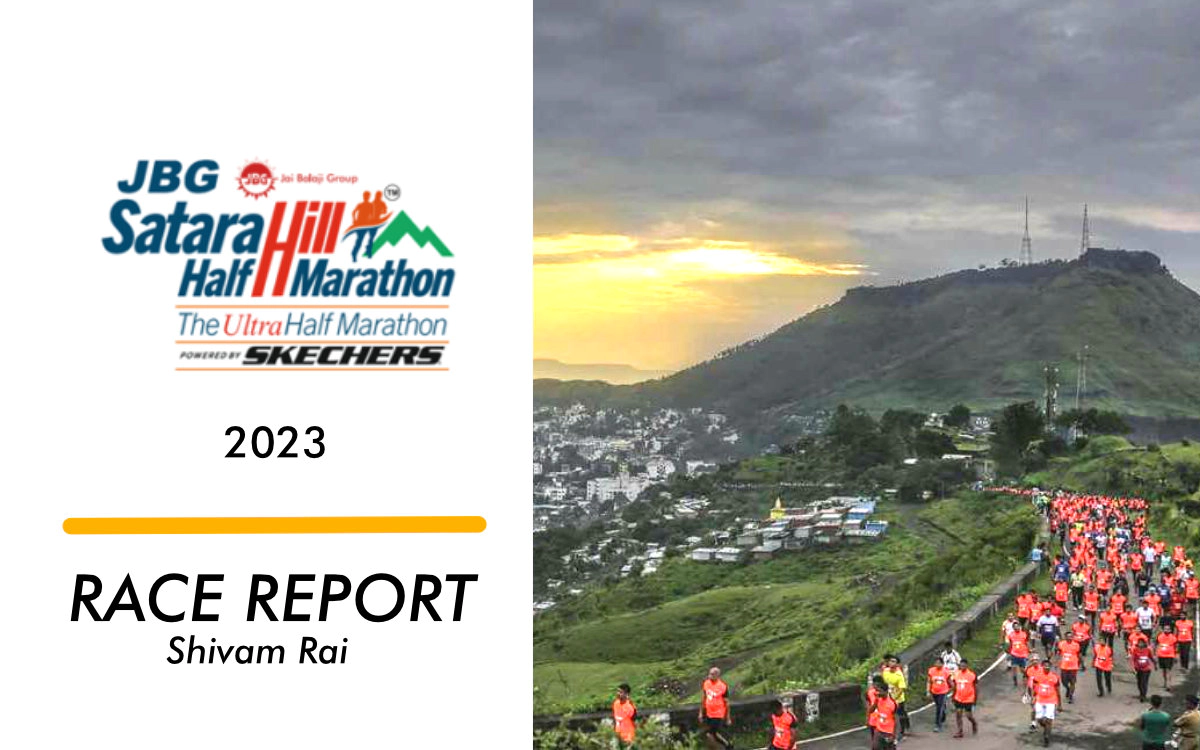
Adidas Ultraboost 22
Having recently completed a grueling Mumbai summer training block in the humid conditions, I had crafted an 8-week training plan for the JBG Group Satara Hill Half Marathon 2023. This was my second long-distance hill run after the Tata Ultra Marathon 50 km 2023, and the aim was to finish strong and run smartly on the undulating hills of Satara. I had checked pacing strategies from the Fit Page who is a partner for this race.
The course of SHHM 2023, has the hills start from the word go and continue until the 8th kilometer. Hence as part of training I ran in the hills of Neral and Matheran to be prepared for such elevation. My training plan included long runs, interval runs, and tempo runs, as well as short bursts of strength training combined with swimming and yoga for mobility. My typical training week is structured as 5 days of running, with Mondays for rest, and Saturdays for strength training. The running schedule was as follows: Tuesdays - Long hill run, Wednesdays - running on tired legs, Thursdays - Interval run, Fridays - Tempo run, and Sundays - Long run. Having a rest day after a long run helped me to recover better.
During my training, I peaked with a weekly mileage of 45 kms with lots of hill runs. Here are some variations of hill runs that I ran during training -
I ran at the goal pace for shorter distances of 3-5 kms (uphill) to get used to the race pace. During one of my long runs, I simulated the race day by running the entire uphill distance (8 km) and then running back down the same 8 km stretch. I also consumed electrolytes and gels in my training run to simulate actual race day scenarios.
Most of my long runs were in Brooks Ghost 14, Interval and tempo runs in Puma Deviate Nitro, and for the race day I used Adidas Ultra Boost 22.
For recovery during training, I increased my intake of protein rich foods like Soya and Paneer and made sure to have electrolytes replenished every post race session.
During the beginning of the season, I ran 5km and 10 km runs, which helped me to estimate my aerobic pace at 7:30 mins/km. As a run up to the marathon, I participated with my running group on the Neral - Matheran hill track which has a total distance of 8 km with elevation of 650m.
I took a week of taper, where I focussed only on Aerobic runs and runs not more than 12 kms totalling to 40 kms during this week. I also added one mobility day to the schedule to mobilize and relax muscles from weeks of hard training prior.
I traveled to Satara on Saturday with my friends from the suburban Mumbai locality of Ambernath in a Tempo Traveller. We reached the expo by 4 pm and collected the bib. I did not spend much time on foot, as most of the travel was by vehicle and the starting point of the race was within walking distance of my accommodation. I had my last meal (Khichdi) at 9 pm on Saturday (previous night of the race), and woke up at 4:30 am on race day.
Did some asanas and back stretching and had black coffee, before reaching the start point for the race. I walked to the start point with my mates (all participating for the first time) and reached there by 6 am. We had enough time to soak in the energy from fellow runners, check-in our bags, and to warm up.
To execute my strategy, I found the 2:40 bus at the start line in section A and decided to stick with the bus during the ascent portion. I intended to finish strong and run negatively split times up to the finish line. I divided the entire race into three sections: the first 8 km climb, the next 5 km flat, and the next 8 km downhill. I followed the +1, 0 and -1 mins pacing rule. Run on up-hill sections at +1 mins off my target pace, stick to target pace on flats, and -1 min on downhills. While being mindful of my heart rate on the climb, I stayed mostly in Zone 3 and allowed myself to go into Zone 4 afterwards.
Here is an illustration:
| Elevation | Effort | Pace |
| Up hill | Conversational | 7:30 mins/km |
| Flat | Slightly difficult | 6:30 mins/km |
| Downhill | Broken words | 5:30 mins/km |
I had made up my mind to keep my average pace around 7:50 mins/km for the initial climb up-to the 8km mark as this was supposed to be the most difficult part of the run. I made sure to stick to the 2:40 bus with brisk walks on the steep uphills and take tangents as much as possible.
On the fueling front, the plan was to take gel every fifth kilometer and salt water intermittently every 3.5 kms. This is something that I learnt from TUM 2023 where I experienced muscle cramps.
The first 1.6 kms before the climb had gradual elevation and I had to control myself to stick to the planned pace and not be influenced by all energy in the air at the start line. As I started climbing the hilly road, I dropped my pace down from 6:30 mins/km to 7:50 mins/km. Constant cheers along the route helped me to keep the cool till 8th km. Huge shout out to all the volunteers and the local police personnel who were cheering us early in the morning.
After the initial 8 kms at the controlled pace, I found my rhythm for the race. The focus shifted from HR to pace. I adjusted my strides to match the elevation.
I saw the leading pack on the returning route and was just bewildered by the effort they were putting in. From the 8th km to 13th km the route has gradual elevation and occasional small climbs.
I kept reminding myself about how I ran conservatively the first half of the race on the uphills and to use the downhills to my advantage and post a negative split. At 4 kilometers to the finish line, a quick look at my Garmin watch, which reminded me that 24 mins left for the sub 2h:30m finish.
I was feeling good and there were no signs of cramps. I took the leap of faith to run at 5:30 pace and started overtaking runners one by one. At the 18th km mark, I took the 4th and final gel and prepared myself for the finishing line sprint.
Finally, I crossed the finish line at a speed that I felt like I’m sprinting at 5:00 min/km and my garmin read 2:28:xx. As I made my final dash, a count-down timer for silver medal at the finish line read 37 seconds, and it took all the might I had to dash through, a feeling that I cherish for life.
After crossing the finish line, the volunteers were sorting people according to their finish timings in silver and bronze categories. SHHM has a unique way to classify runners according to the finish line timings, sub 2 hr runner gets a gold medal, between 2 hr to 2.5 hr gets a silver medal and rest of the finishers would get bronze medal. I went to the recovery zone to use ice packs and sponge baths to freshen up after stretching with runners from the Ambernath Runners Foundation.
Thanks to Team Geeks on Feet for the newsletter, which featured a race report recently, and nudged me into writing and recollecting all my memories.
My next goal is to finish a sub 1h:45m half marathon at the Vedanta Delhi Half marathon 2023, and finish the Procam slam this year. For now, I’m training in Jamshedpur with fellow runners at JRD stadium and also working to grow the running community around Jamshedpur, where I currently live. Maybe I would come back to this race again to redeem the gold medal for myself and finish in sub 2 hr category. I would like to thank my training team at Ambernath Runners Foundation and Piyush Runner for accompanying me on my long runs, and Jamshedpur Runners for instilling the running routine into me.

Shivam is an amateur runner working with Tata Steel, runs with Ambernath Runners Foundation, and is popularly known as the Hype person.